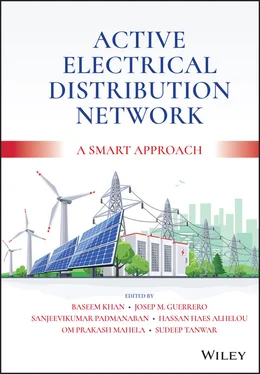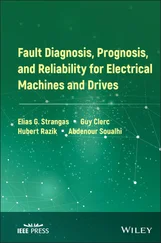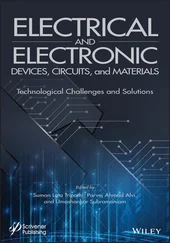Active Electrical Distribution Network
Здесь есть возможность читать онлайн «Active Electrical Distribution Network» — ознакомительный отрывок электронной книги совершенно бесплатно, а после прочтения отрывка купить полную версию. В некоторых случаях можно слушать аудио, скачать через торрент в формате fb2 и присутствует краткое содержание. Жанр: unrecognised, на английском языке. Описание произведения, (предисловие) а так же отзывы посетителей доступны на портале библиотеки ЛибКат.
- Название:Active Electrical Distribution Network
- Автор:
- Жанр:
- Год:неизвестен
- ISBN:нет данных
- Рейтинг книги:5 / 5. Голосов: 1
-
Избранное:Добавить в избранное
- Отзывы:
-
Ваша оценка:
- 100
- 1
- 2
- 3
- 4
- 5
Active Electrical Distribution Network: краткое содержание, описание и аннотация
Предлагаем к чтению аннотацию, описание, краткое содержание или предисловие (зависит от того, что написал сам автор книги «Active Electrical Distribution Network»). Если вы не нашли необходимую информацию о книге — напишите в комментариях, мы постараемся отыскать её.
Discover the major issues, solutions, techniques, and applications of active electrical distribution networks with this edited resource Active Electrical Distribution Network: A Smart Approach
Active Electrical Distribution Network: A Smart Approach
Active Electrical Distribution Network — читать онлайн ознакомительный отрывок
Ниже представлен текст книги, разбитый по страницам. Система сохранения места последней прочитанной страницы, позволяет с удобством читать онлайн бесплатно книгу «Active Electrical Distribution Network», без необходимости каждый раз заново искать на чём Вы остановились. Поставьте закладку, и сможете в любой момент перейти на страницу, на которой закончили чтение.
Интервал:
Закладка:
Chapter 20 discussed demand response techniques and smart home energy management.
Chapter 21 discussed a sustainable building lightning solution for energy conservation in different geographical conditions.
Chapter 22 discussed the smart metering infrastructure for the smart grid system.
Acknowledgments
This book, Active Electrical Distribution Network: A Smart Approach , is the outcome of the inspiration and encouragement given by many individuals for whom these words of thanks are only a token of our gratitude and appreciation for them.
Our sincere gratitude goes to the peoples who contributed their time and expertise to this book. We highly appreciate their efforts in achieving this project. The editors would like to acknowledge the help of all the people involved in this project and, more specifically, the editors would like to thank each one of the authors for their contributions and the editorial board/reviewers regarding the improvement of quality, coherence, and the content presentation of this book.
Second, the editors would like to express their sincere thanks to Juliet Booker, Becky Cowan, and Sandra Grayson of Wiley Publishing Group for their continuous support and giving us an opportunity to edit this book.
The editors are thankful to our family members for their prayers, encouragement, and care shown towards us during the completion of this book. Thank you all.
We also express our gratitude to the GOD for all the blessings!!!
Baseem KhanHawassa University, Hawassa, Ethiopia Josep M. GuerreroAalborg University, Aalborg East, Denmark Sanjeevikumar PadmanabanAarhus University, Herning, Denmark Hassan Haes AlhelouTishreen University, Latakia, Syria Om Prakash MahelaPower System Study Division, RVPN, Jaipur, Rajasthan, India Sudeep TanwarNirma University, Ahmedabad, India
List of Contributors
Hassan Haes Alhelou Tishreen University, Syria
Sanjana Babu Vellore Institute of Technology, Vellore, India
Baidyanath Bag National Institute of Technology, Raipur, India
Laxmidhar Behera Indian Institute of Technology Kanpur, Uttar Pradesh, India
Bharat Bhatia Manipal University, Jaipur, India
Gajendra Singh Chawda Indian Institute of Technology, Jodhpur, Rajasthan, India
Sajjad Fattaheian-Dehkordi Sharif University of Technology, Iran
Hooman Firoozi School of Technology and Innovations, University of Vaasa, Vaasa, Finland
Man Mohan Garg Malaviya National Institute of Technology, Jaipur, Rajasthan, India
Mohammad Gholami Sharif University of Technology, Iran
Esayas Gidey Hawassa University, Ethiopia
Sunil Kumar Goyal Manipal University, Jaipur, India
Josep M. Guerrero Aalborg University, Denmark
Shu-Yuen Ron Hui Imperial College London, UK
Sanjay Jain R.K.D.F. University, Bhopal, M.P, India
Siddharth Jain Vellore Institute of Technology, Vellore, India
Shilpa Kalambe Dr. Babasaheb Ambedkar College of Engineering and Research, Nagpur, India
Bhojraj N. Kale Dr. Babasaheb Ambedkar College of Engineering and Research, Nagpur, India
Hosna Khajeh School of Technology and Innovations, University of Vaasa, Vaasa, Finland
Baseem Khan Hawassa University, Ethiopia
Meher Preetam Korukonda Indian Institute of Technology Kanpur, Uttar Pradesh, India
Pankaj Kumar Department of Electrical Engineering, Rajasthan Technical University, Kota, Rajasthan, India
Hannu Laaksonen School of Technology and Innovations, University of Vaasa, Vaasa, Finland
Rajesh Kumar Lenka National Institute of Technology Roukela, Odisha, India
Meisam Mahdavi São Paulo State University, Brazil
Om Prakash Mahela Power System Planning Division, Rajya Vidyut Prasaran Nigam Ltd, Jaipur, Rajasthan, India
Ujwala Malkhandale Priyadarshini Indira Gandhi College of Engineering, Nagpur, M.S., India
Hesam Mazaheri Sharif University of Technology, Iran
Ashwini Ramachandran Nair Vellore Institute of Technology, Vellore, India
Kinfe Negash Hawassa University, Ethiopia
Mohamad Amin Rajabi Nezhad Power Quality Research Lab, Iran University of Science and Technology, Tehran, Iran
Anup Kumar Panda National Institute of Technology Roukela, Odisha, India
Bhuvnesh Rathore MBM, Jodhpur, Rajasthan, India
Mohd Tayyab Saeed Al-Mostajed Technologies Co. LLC, United Arab Emirates
P. Sanjeevikumar Aarhus University, Denmark
Amit Saraswat Manipal University, Jaipur, India
Yashwant Sawle Vellore Institute of Technology, Vellore, India
Abdul Gafoor Shaik Department of Electrical Engineering, Indian Institute of Technology, Jodhpur, Rajasthan, India
Pierluigi Siano University of Salerno, Italy
Bhuwan Pratap Singh Manipal University, Jaipur, India
Siew-Chong Tan The University of Hong Kong, Hong Kong
M. Thirunavukkarasu Vellore Institute of Technology, Vellore, India
Yun Yang The Hong Kong Polytechnic University, Hong Kong
1 Electricity Distribution Structures and Business Models Considering Smart Grid Perspectives
Baidyanath Bag
Department of Electrical Engineering, National Institute of Technology Raipur, Chhattisgarh, India
1.1 Introduction
The deregulation process has faced many difficulties and various problematic sectors are still being explored and resolved [1–5]. A business model describes the strategy by which an organization creates, delivers, and captures values. A suitable business model articulates the value created to users by using the product or service. It also identifies the market segment, defines the value chain to estimate the cost structure and profit earning ability, judges the position of the firm with respect to other competitors, and provides the competitive strategy to the firm to build up its identity. Because after manufacture a product is sold in a market, after being generated electricity is also sold like a market product. Hence a business model is also necessary for electricity distribution in order to articulate its value position. The process of delivery of electrical energy from the point of its generation up to the point of consumption needs a business strategy in each and every step of its production. The major parts of the business in the electrical sector lie with generation, transmission, and distribution processes. Of these three major business procedures in the power sector, distribution is the most growing concern sector in the smart grid environment, where the motivation to hold a business model is to be found in each and every step of the job needed to carry out the task of power distribution among consumers. In the power distribution sector the major functions lies with:
Infrastructure creation and its operation and maintenance.
Creation of an organizational structure.
Collection of big data and its analysis.
Policy framing and framing different processes.
Managing work, asset, and demand.
Developing different models related to finance, business, system, and technology.
Pricing, billing, collection, and awareness related activities.
An opportunity exists for a distinct business model for each of the above activities. Hence there is an essential need to find a suitable business model that will divide all the above actions into a distinct business. As the major concern of the changes under smart grid initiatives exists in the power distribution sector and the varieties of these changes are large in number corresponding to their required expertise, a suitable business model for the power distribution sector is an utmost requirement to ensure smart grid implementation.
Читать дальшеИнтервал:
Закладка:
Похожие книги на «Active Electrical Distribution Network»
Представляем Вашему вниманию похожие книги на «Active Electrical Distribution Network» списком для выбора. Мы отобрали схожую по названию и смыслу литературу в надежде предоставить читателям больше вариантов отыскать новые, интересные, ещё непрочитанные произведения.
Обсуждение, отзывы о книге «Active Electrical Distribution Network» и просто собственные мнения читателей. Оставьте ваши комментарии, напишите, что Вы думаете о произведении, его смысле или главных героях. Укажите что конкретно понравилось, а что нет, и почему Вы так считаете.











